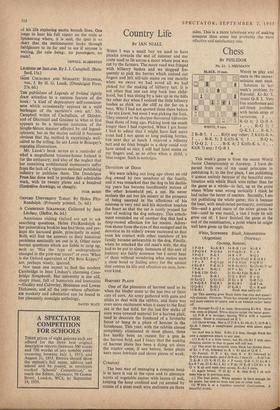Chess
By PHILIDOR
Nu. 13. I. NEUMANN
BLACK, 10 men. WHITE to play and mate in tea) moves: solution next week.
Solution to last week's problem by Rietveld: Kt-Kt 5, .┬▒.( *I line interference and threat Q-K 3. Very self-block problem with lavish array of
variations. 1 . . R-Q 6; 2 Q-B 6. 1 . . . R-Q 3; 2
2 R-13 7. 1 . R(Q) any other; 2 Kt(8)-K 6.
I . . . R-K 5; 2 Kt(5)-K 6. 1 . . . I3-Q 6; 2 Q-Q 2. 1 . ŌĆó . B-K 4; 2 Kt(8)-K 6. 1 . Kt(R 7) any; 2 Q-B 3.
This week's game is from the recent World Junior Championship at Antwerp. I have de- parted from two of my usual principles in publishing it; in the first place, I am publishing it almost entirely because of the beautiful com- bination with which Black wins rather than for the game as a wholeŌĆöin fact, up to the point where White went wrong tactically I think he had rather the better of matters. Secondly, I am not publishing the whole game; this is because the loser, with misdi reeled pertinacity, continued thisŌĆöand a good many of the other games he lostŌĆöuntil he was mated, a vice I hope he will grow out of. 1 have finished the game at the end of the combination, a point where he might well have given up the struggle.
White, SCHWEBER B lack, JOHANNESSEN
(Argentine) (Norway)
Opening, Bemoni.
I P-Q 4 Kt-K 133 14 R-K 1 (r) Kt-K 4
2 P-Q14 4 P-Q 13 4 15 P-Q Kt 4 P x P 3 P-Q 5 P-K 3 16 R x P B-Q 2 4 Kt-Q113 P xP 17 Q-Kt 31(d) KR-QtSl
5 P x P P-Q 3 (a) 18 P-B 31(e) P-Q R 4!
6 Kt-B 3 P-K Kt 3 19 R-Kt 6(f) Kt (3)-Kt 5! (g)
P-K 4 B-Kt 2 20 P x Kt Kt x P
8 B-K 2 (b) 0-0 21 Kt-Kt 5 (h) R-B 61 90-0 R-K 1 220 x R (i) 11 x Q
10 Kt-Q 2 Q Kt-Q 2 23 Kt x 13 Q-R 5 (j) 11 P-Q R 4 P-Q R 3 24 Kt-I3 3 Q-B 7 ch 12 Q-11 2 R-Kt I 25 K-R I Q X R and
13 R-Kt I Q-K 2 Black woo easily (k) (a) This opening gives Black fairly free play and queen side chances. However, White has sounder pawn formation and more control of centre, and is on balance rather better Oil.
(I) Stronger Kt-Q 2 at once, threatening 1(1-11 4. How- ever, even as 'played, White retains rather the better game.
(c) P-B 4 is stronger, leaving White with a superior position. Rook is misplaced on K I.
(d) Quite wrong. Bast is 17 P-B 4, Kt (4)-Ks 5; 18 P-R 3, Kt-R 3 (best); a complicated position with about equal chances.
(c) And this Is fatal. B-Kt 2 is best, though Black has now a dangerous attack in any case.
(I) R-Q 4 is a little how, but Kt (3)-Kt 5 with com- bination similar to that in game will still win.
(g) This must be accepted, since Black has double threat of Kt x P ch, followed by R. x Kt and of Q-R 5. Forced. If B x Kt, then P. x Kt followed by B-Q 5 eh wins easily, and if 20 B-Kt 2 then 20...11-Q 5 elt, 21 K-R 1(21 K-B 1?, Kt x P mate), Q-R 5; 22 Kt-B 3: Kt-B 7 ch; 23 K-Kt I, Kt x P ch; 24 K-R 1(24 Kt x B, Q x R ch and mato next move), Kt-Kt 6 mate.
(i) Again forced. If 22 Kt x It, then B-Q 5 eh with same line as in previous note.
(i) The final point. White appears to have enough for his queen, but now he must lose one or other rook.
(k) White is at a hopeless material disadvantage. A beautiful attack.


































 Previous page
Previous page